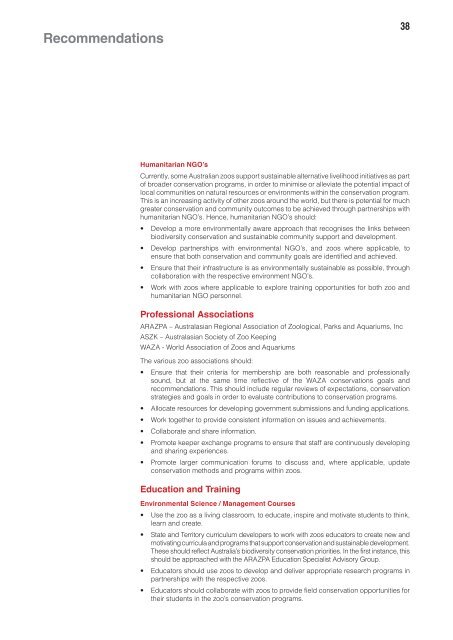Indonesian Conservation Management Practices & the Australian ...
Indonesian Conservation Management Practices & the Australian ...
Indonesian Conservation Management Practices & the Australian ...
- No tags were found...
Create successful ePaper yourself
Turn your PDF publications into a flip-book with our unique Google optimized e-Paper software.
Recommendations38Humanitarian NGO’sCurrently, some <strong>Australian</strong> zoos support sustainable alternative livelihood initiatives as partof broader conservation programs, in order to minimise or alleviate <strong>the</strong> potential impact oflocal communities on natural resources or environments within <strong>the</strong> conservation program.This is an increasing activity of o<strong>the</strong>r zoos around <strong>the</strong> world, but <strong>the</strong>re is potential for muchgreater conservation and community outcomes to be achieved through partnerships withhumanitarian NGO’s. Hence, humanitarian NGO’s should:• Develop a more environmentally aware approach that recognises <strong>the</strong> links betweenbiodiversity conservation and sustainable community support and development.• Develop partnerships with environmental NGO’s, and zoos where applicable, toensure that both conservation and community goals are identified and achieved.• Ensure that <strong>the</strong>ir infrastructure is as environmentally sustainable as possible, throughcollaboration with <strong>the</strong> respective environment NGO’s.• Work with zoos where applicable to explore training opportunities for both zoo andhumanitarian NGO personnel.Professional AssociationsARAZPA – Australasian Regional Association of Zoological, Parks and Aquariums, IncASZK – Australasian Society of Zoo KeepingWAZA - World Association of Zoos and AquariumsThe various zoo associations should:• Ensure that <strong>the</strong>ir criteria for membership are both reasonable and professionallysound, but at <strong>the</strong> same time reflective of <strong>the</strong> WAZA conservations goals andrecommendations. This should include regular reviews of expectations, conservationstrategies and goals in order to evaluate contributions to conservation programs.• Allocate resources for developing government submissions and funding applications.• Work toge<strong>the</strong>r to provide consistent information on issues and achievements.• Collaborate and share information.• Promote keeper exchange programs to ensure that staff are continuously developingand sharing experiences.• Promote larger communication forums to discuss and, where applicable, updateconservation methods and programs within zoos.Education and TrainingEnvironmental Science / <strong>Management</strong> Courses• Use <strong>the</strong> zoo as a living classroom, to educate, inspire and motivate students to think,learn and create.• State and Territory curriculum developers to work with zoos educators to create new andmotivating curricula and programs that support conservation and sustainable development.These should reflect Australia’s biodiversity conservation priorities. In <strong>the</strong> first instance, thisshould be approached with <strong>the</strong> ARAZPA Education Specialist Advisory Group.• Educators should use zoos to develop and deliver appropriate research programs inpartnerships with <strong>the</strong> respective zoos.• Educators should collaborate with zoos to provide field conservation opportunities for<strong>the</strong>ir students in <strong>the</strong> zoo’s conservation programs.

















